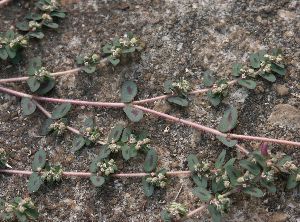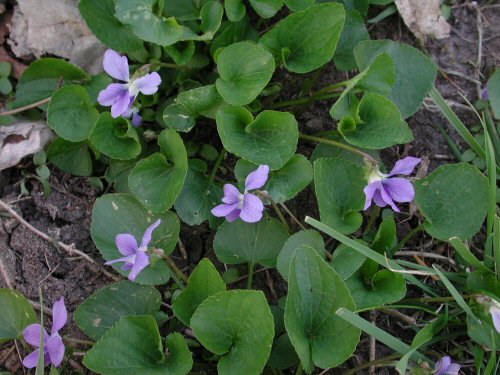White Clover
White clover is the most common type of clover we have in the northeast. This perennial usually flowers in late May, taking the “annoying weed” baton from dandelions, which are going to seed when we first see clover.
Clover usually grows in a low mat, with several plants intertwined. It can be very difficult to control due to its aggressive spread and waxy layer on the leaves.
Its white flowers are very attractive to bees, so clover control can be pretty important for those allergic to bee stings.
Crabgrass
Only one other weed makes us as crabby as dandelions do, and that’s crabgrass!
Crabgrass is an annual weed, which means that seed germinates in the spring and the plant dies in the fall, completing its entire life in one growing season.
Crabgrass is another weed that loves the heat. It grows where it’s the hottest. Curbs, walkway edges, driveway edges, and every other area where heat accumulates are where crabgrass thrives.
We treat every lawn with a pre-emergent herbicide at our first service specifically to control crabgrass, but that will not control all of it. That’s why we also spray it when we see it at the summer service.
Dandelions
The dandelion is the most common broadleaf weed in lawns.
It is a perennial, which means the same plant lives from year to year.
It flowers in the spring, when conditions are just warming up (around the end of April up here). Once it goes to seed, it tends to go dormant in the summer, unless the summer is cool and rainy, in which case, it may flower again.
The seeds it produces in the spring will germinate in the fall and they’ll grow rapidly until the first frost.
They’ll wake up in early spring and flower.
Spotted Spurge
Spotted spurge rivals crabgrass in “customer annoyance factor” for summer weeds.
It, like crabgrass, is an annual weed, meaning that it completes its entire life in one growing season.
It germinates in late spring and can grow out in mats much the same as crabgrass does. It’s most common where the lawn is the hottest: along curbs, driveways, walkways and any other place that collects heat.
It starts out all green but as it matures, it develops purple spots in the center of each leaf.
Our early spring pre-emergent weed control application can minimize it, but its aggressive nature often allows it to break through the weed control barrier.
Wild Violets
Violets are the most difficult weed to control. Period. They are perennial and grow in patches. Each plant is grafted to another and takes and it takes an aggressive control strategy to minimize them.
Fortunately, violets are not the ugliest weed we have. Many customers find them attractive and don’t mind their presence in their lawns, to a degree.
We often find them in older lawns, where violets were often used as a desirable ground cover in planting beds, but escaped onto lawns. The whole colony of violets can be grafted together so controlling them is akin to “whack-a-mole.” You kill a patch here and another shows up there.
Yellow Nutsedge
Yellow nutsedge is one of the more troublesome weeds in the summer lawn.
It’s a yellowish green perennial that is very hard to control.
It emerges from a very deep root, which can send up a number of individual plants. That’s why we often see it in clusters in certain sections of lawn.
It sprouts during hot weather and grows much more quickly than the rest of the lawn after a cut. That’s what really annoys us!
We can treat nutsedge as part of our regular summer service, but an additional application is usually required for best control.
For more information regarding diseases that may be effecting your lawn health, please do not hesitate to give us a call, or shoot us an email.









